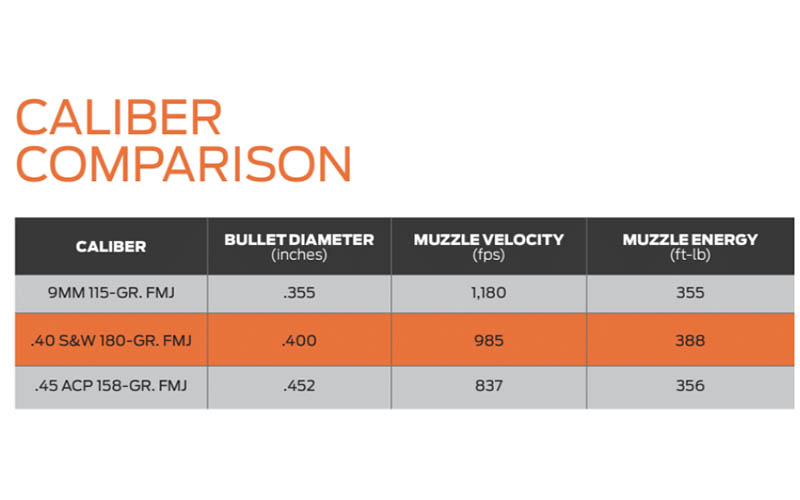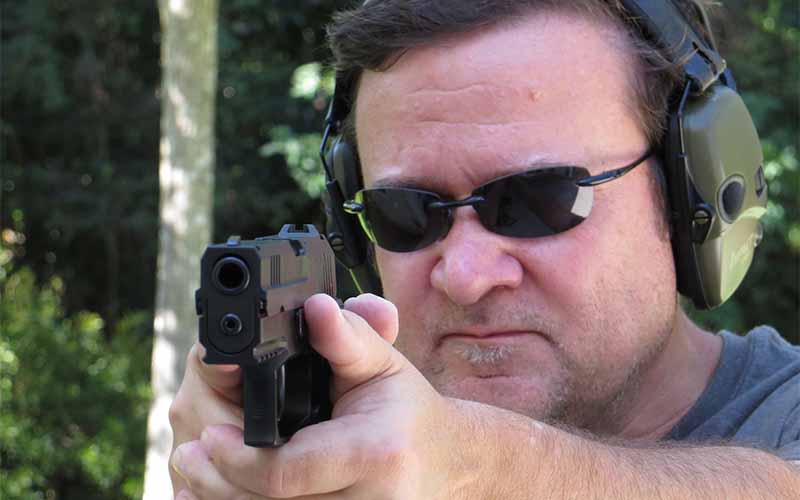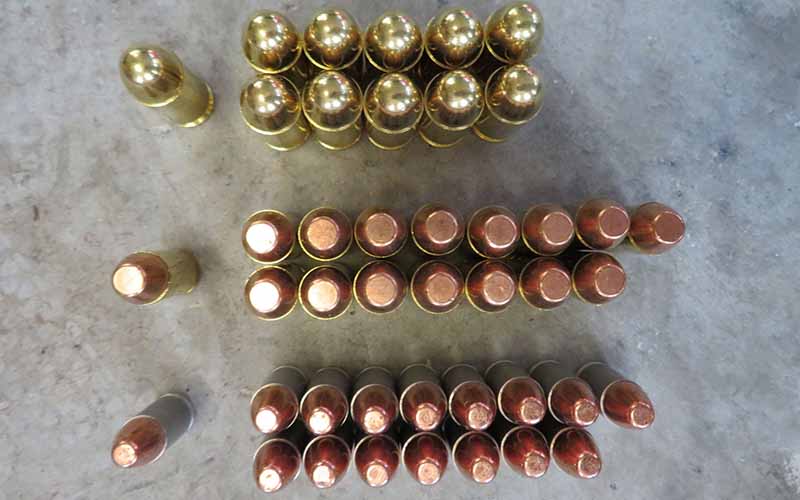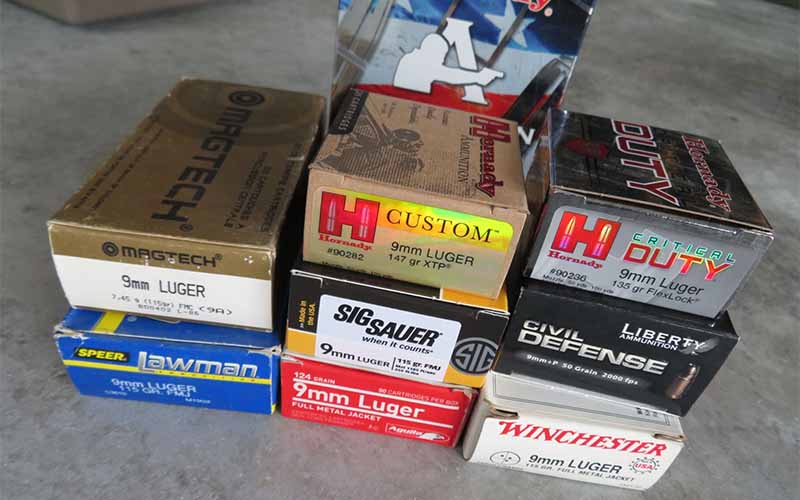In the eternal debate of .40 S&W Vs. .45 ACP Vs. 9mm, which cartridge reigns supreme for concealed carry and self-defense?
So now that we know a bit about the specifications and data for the 9mm cartridge, what is it that makes it so popular? It does not have stellar, tack-driving accuracy like other pistol calibers, nor does it have the power of other cartridges. It is far from the perfect cartridge but is still the most prevalent worldwide. Even science gives the 9mm low marks compared to larger calibers.
It’s simple physics. A bigger, heavier bullet carrying more energy means a deeper and larger wound channel. So why is the 9mm king? There are three reasons: Shootability, increased magazine capacity, and ammunition choices.
Before we get into these, let’s talk physics and math. A light projectile sheds velocity and energy faster than a heavier one. More velocity equates to more energy. More energy factors into the amount of penetration, which affects terminal performance. Energy is the benchmark by which we rate a bullet’s performance. To sum up this fast physics lesson: all things being equal, a larger, heavier bullet will penetrate deeper than a lighter one.
The move to the 9mm was not an instant success, as the Illinois State Police learned. As mentioned in an earlier chapter, they were one of the first U.S. law enforcement agencies to adopt the 9mm in the Smith & Wesson Model 39. The standard-issue round was either 100- or 115-grain, standard velocity. The load was mediocre at best as the troopers found out, but when they changed to 115-grain hollow-point +P+, those .380-inch bullets leaving the muzzle of their Model 39s at a velocity of 1,300 fps changed the game. The initial 9mm rounds at the time used by law enforcement did not yet reach the nine’s full potential.
One of the issues our military experienced with the 9mm was dissatisfaction with the M9 pistol specifically and ammunition in general. It boiled down to a report compiled by the Center for Naval Analyses (CNA) and released in 2006 titled, “Soldier Perspectives on Small Arms in Combat.” The report detailed a formal independent review of soldier opinions of their small arms in combat situations. Specifically, the Project Manager, Soldier Weapons (PMSW) wanted to know soldier perspectives on the reliability and durability of the M9 pistol, as well as the M4 and M16 (A2 and A4) rifles, and the M249 light machine gun. These four weapon systems are the standard-issue guns being used by Army soldiers in Iraq and Afghanistan.
Just to level set the results, weapon reliability is defined as “soldier level of confidence that their weapon will fire without a stoppage in the combat environment.” Weapon durability is defined as “soldier level of confidence that their weapon will not suffer breakage or failure that necessitates repair before further use.” Survey participants included over 2,600 soldiers who had returned from Iraq or Afghanistan and who had engaged in a firefight using the weapons listed.
The net result was that soldiers were least satisfied with the M9 compared to the other weapons and “the most frequent recommendations included weapons and ammunition with more stopping power/lethality; higher quality magazines for the M9, M4 and M16; more durable ammo belt links and drum systems for the M249; and reduced size and weight in the M16 and M249.”
Call it lethality, stopping power or knock-down power, but there is no such thing as a caliber with this magic attribute. The truth is a combination of bullet placement and design, and follow-up, are what stop a threat. If a shooter does his job and places the shot accurately the 9mm can stop a threat. Our bodies can take an enormous amount of punishment. Our organs can move around inside us, so what might have been a good hit is not. There are numerous examples of people who are shot in a gunfight and did not realize they were hit until after the fight was over.

It may be ironic that the Mozambique Drill is a technique used with a Rhodesian mercenary, Mike Rousseau, during the Mozambican War of Independence from 1964 to 1974. Rousseau was fighting at the airport at Lourenço Marques, which is now called Maputo. He turned a corner and came face-to-face — about 10 paces — with a FRELIMO guerrilla armed with an AK-47. Armed with a Browning HP35 pistol chambered in 9mm, Rousseau immediately brought up his Hi Power and shot the guerrilla twice in the chest.
This was a traditional “double tap” maneuver. According to Rousseau during a conversation with Jeff Cooper, Rousseau hit the guerrilla on either side of the sternum, which is typically sufficient to kill a man. Yet the guerrilla was still advancing, so he tried for a headshot and instead hit the guerrilla through the base of his neck, severing the spinal cord. Cooper, the founder of the Gunsite Academy shooting school and father of the “modern technique” of pistol shooting, decided to incorporate a drill similar to what Rousseau had experienced. Cooper called it the “Mozambique Drill.”
The drill has you fire the first two shots to the center of mass and then a slight pause. The pause allows you to assess the situation and determine if a third shot is needed to the head. The drill has since been renamed Failure Drill or Failed to Stop Drill due to political correctness. No doubt Cooper is rolling over in his grave over that, since he had no patience for political correctness — only fast, precise shooting.
I’ve talked to some recent veterans who have combat experience with the M9 and, according to some of them, the reason it has a 15-round magazine is that you need two shots to immobilize an opponent. That is due to the M882 cartridge, the U.S. military load for the 9mm—not the handgun itself. The military has plans to change the 9mm load and may even walk away from the FMJ ball ammo and use a more effective bullet.
With no further ado, here are the reasons the 9mm beats all other cartridges for combat and self-defense.
Shootability
When the 10mm Auto was dropped by the FBI in favor of the .40 S&W, law enforcement agencies nationwide followed suit and shifted to the .40, dropping the 9mm in what seemed like the blink of an eye. Even so, for most LE agencies the breakup with the nine would be short. The .40 S&W had what they wanted: a larger bullet at a higher velocity that created a larger and hence more lethal wound channel. At one time, manufacturers were introducing pistols in .40 S&W first and then following up with the same handgun chambered in 9mm. The H&K USP model is an example. Today, the .40 S&W might be considered, but now most handgun manufacturers introduce 9mm first, then .40 S&W and maybe .45 ACP.

The .45 ACP has been in use with our military since WWI and is a proven combat caliber. The problem with it is recoil. Even with full-size, steel receiver pistols like the 1911, the .45 ACP is a handful to control. Pistols chambered in 9mm — from subcompacts to full-size models — have less recoil and that translates into you shooting the pistol better. Better shooting means better accuracy. Faster follow-up shots are one of the 9mm’s greatest benefits.
.40 S&W Vs. .45 ACP Vs. 9mm: Magazine Capacity
Additional magazine capacity of the 9mm is a benefit over the .40 S&W and .45 ACP. For example, look at the Smith & Wesson M&P series. The M&P 9 has a capacity of 17+1 rounds. The M&P 40 has a capacity of 15+1, and the M&P 45 has a 10+1 round capacity. The 9mm offers less reloading and more shooting — something to think about if you get into a gunfight. The ability to confront multiple threats with more firepower and not have to take time to reload is a plus. Most who carry do not have spare ammo on them (they should). Concealing a 9mm pistol means more rounds on hand.

Ammunition Choices
Since the 9mm is so popular there are many bullet options loaded by nearly every ammunition manufacturer. From fast 115-grain ammo to slower and heavier 147-grain rounds, the 9mm offers choice. The cost of 9mm ammo is less than .40 S&W and .45 ACP. Plus, it is easy to find 9mm ammo at nearly any store that sells ammunition. That means you can train more often and longer for less cost.

The 9mm was once embraced, tossed aside, and now embraced again. It’s not a compromise cartridge — you now have more round capacity with bullets that provide wound cavities pacing those caused by larger cartridges. Times have changed and so has the 9mm.
Editor’s Note: This article is an excerpt of 9mm: Guide to America’s Most Popular Caliber.
More Handgun Ammo Debates:
 NEXT STEP: Download Your Free Storm Tactical Printable Target Pack
NEXT STEP: Download Your Free Storm Tactical Printable Target Pack
62 Printable MOA Targets with DOT Drills – Rifle Range in YARDS This impressive target pack from our friends at Storm Tactical contains 62 printable targets for rifle and handgun range use. Target grids and bullseye sizes are in MOA. Ideal for long-range shooting!
Subscribe to the Gun Digest email newsletter and we’ll send your print-at-home target pack right away. Just enter your email address below.

